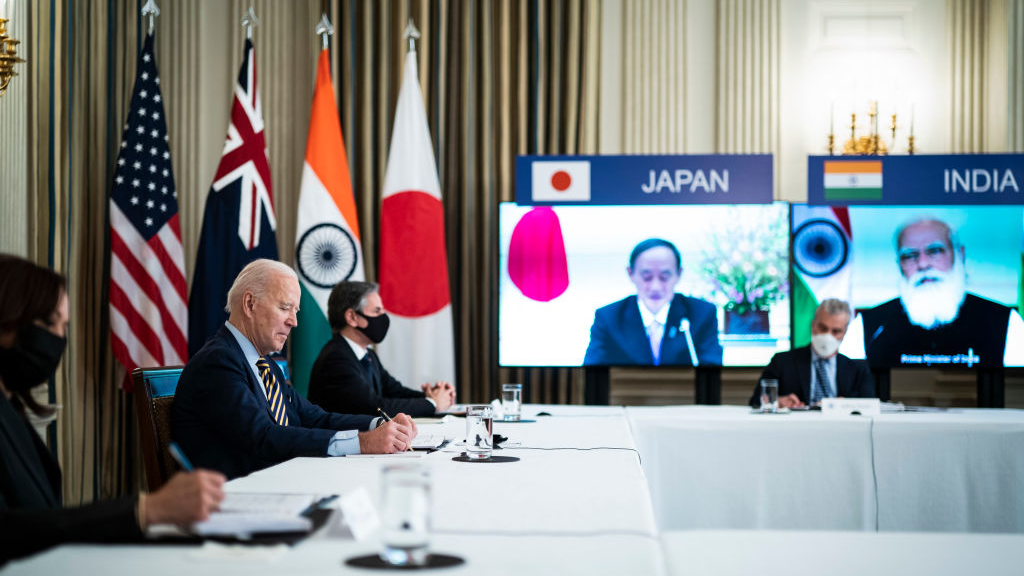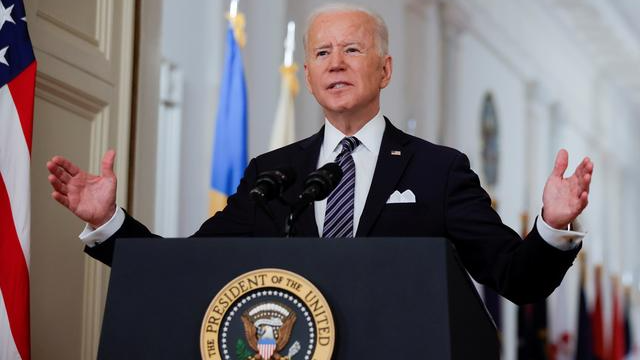
President Joe Biden meets virtually with the Quad in the State Dining Room at the White House, March 12, 2021. /Getty
President Joe Biden meets virtually with the Quad in the State Dining Room at the White House, March 12, 2021. /Getty
Editor's note: Bradley Blankenship is a Prague-based American journalist, political analyst and freelance reporter. The article reflects the author's opinions and not necessarily the views of CGTN.
When former U.S. President Donald Trump entered office in 2017, many of his first moves as president, perhaps unwittingly, undermined America's strategic partnerships in the Asia-Pacific region. Now, President Joe Biden sought to undo this damage by convening the leaders of the Quadrilateral Security Dialogue, which includes the United States, Japan, India and Australia, for the very first time.
There was certainly a lot to discuss, especially since COVID-19 and climate change were two of the key points on the agenda. India and the United States together account for over a third of confirmed COVID-19 cases in the world and over a quarter of global deaths. Both countries are also the second and third largest contributors to global greenhouse gas emissions. Dialogue on these two issues is welcome, needed and should be encouraged.
At the same time, this meeting held special importance because it came just days before U.S. and Chinese officials are set to have their first in-person meeting. Though it was not said explicitly, the meeting was clearly designed to be a message to China that America and its allies are a united front against the country's rise.
That is especially the message coming from the U.S. foreign policy establishment, think tank analysts and retired generals. Writing in Foreign Policy this week, fellows at the conservative Hoover Institution at Stanford University, including former U.S. Defense Secretary James Mattis, who served in the Trump administration, argued for strengthening the role of the Quad, as it has come to be called, into something more than it is.
The Quad is often compared to an Asian version of the North Atlantic Treaty Organization (NATO), an alliance of Western countries started during the Cold War to combat the Soviet Union, but it is not.
Currently, the Quad is an informal strategic forum, with limited cooperation nowhere approaching the cooperation level of NATO. There is also no logic behind having an Asian NATO since there is no Asian version of the Warsaw Pact or the Soviet Union. Nonetheless, Mattis and his co-authors pointed out four areas where the forum could expand to limit China's rise: maritime security, supply chain security, technology and diplomacy.
Each of the policy suggestions on these areas, however, carries serious uncertainty since each country has different goals, demands and capabilities on each issue.

U.S. President Joe Biden delivers his first prime-time address as president, Washington, D.C., U.S., March 11, 2021. /Reuters
U.S. President Joe Biden delivers his first prime-time address as president, Washington, D.C., U.S., March 11, 2021. /Reuters
With maritime security, the Quad could pull together naval assets to counter what they perceive to be a challenge from China in maritime security, but to what end? Everyone knows an all-out war is in no one's interests, and for those who can read a map it's clearly not China snooping around the Carribean or building a missile network along the Atlantic coast. If anyone is to blame for the so-called arms race in Asia, that blame lies with Washington.
On supply chain security (a nice way of saying that manufacturing bases should be pulled out of China), it seems that the U.S. foreign policy establishment finds it realistic to undo decades of globalization. Of course this is impractical since building up new supply chains from relative scratch would take decades, at least. Same goes for the issue of technology, which is clearly a stand-in for anti-competitive practices championed by the U.S.
Diplomatically, the past can serve as a good indication of how things would play out if the Quad moved to "contain" China. In 2007, when China was comparatively weaker than it is now, the first iteration of the Quad caved under pressure when it attempted a similar gang-up approach with Beijing. As India, Japan and Australia's largest trading partner is China nearly a decade and a half later, this approach would obviously fail even harder.
In the end, Beijing has little to be afraid of after the Quad meeting. It was clearly a stunt meant to add pressure to the face-to-face meeting set to take place shortly in Alaska, and the Quad is not an anti-Chinese bulwark. Importantly, though, it does show exactly where Biden's Asia policy is going, and it's definitely in stark contrast to his rhetoric about diplomacy and multilateralism.
It seems that Biden and his team are merely trying to create a Cold War-era alliance, or a Bush-era coalition of the willing, to contain China in order to give Trump-era "America First" policies an internationalist feel. There is, however, nothing to actually be gained for anyone in the long-run from this outdated strategy.
(If you want to contribute and have specific expertise, please contact us at opinions@cgtn.com.)

